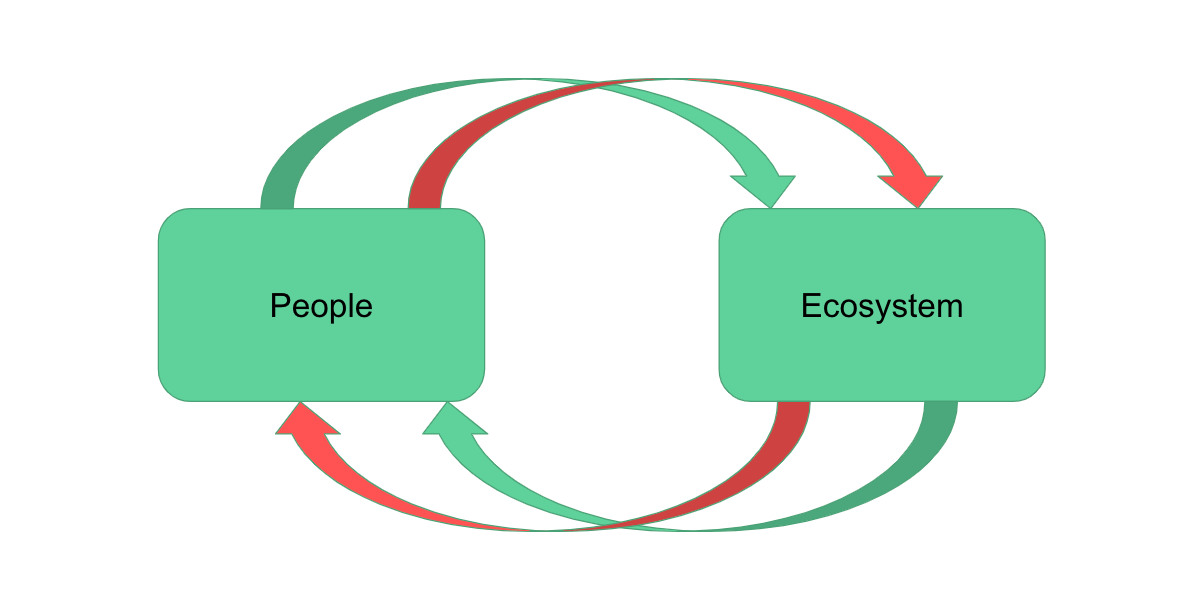Imagine the relationship between humans and nature. Do you think this relationship is balanced? What positive or negative impacts can you think of? And how does your perception of this relationship shape how you fit yourself into the natural world?
These are the questions researchers at the CORE lab are asking to gain a better understanding of how people view the human-nature relationship. Doctoral student Joan Kim, along with many collaborators, leads the Environmental Thinking team, which aims to determine what contributes to the separation between humans and the environment from a cognitive perspective.
When asked broadly about the human-nature relationship in an online study, participants were found to view this relationship as asymmetrical, as people tended to respond that humans have a larger impact on their local natural environment than the environment has on humans. This is an interesting perception, as we know that in reality, nature also has a very large impact on humans.
Participants were found to view this relationship as asymmetrical, as people tended to respond that humans have a larger impact on their local natural environment than the environment has on humans.
The research team also looked at each individual’s environmental concern, or their reasons for being concerned about the environment. This concept can be separated into three categories: biospheric concern (for the sake of nature), altruistic concern (for other people/future generations), or egoistic concern (for the self). For example, someone with biospheric concern would be concerned about the environment for the sake of nature itself, such as plants and animals. The study found that people who hold greater symmetrical beliefs about the human-nature relationship (perceive humans and the environment impacting each other equally) also tend to have greater biospheric concern.
Participants’ “nature relatedness” was also measured to see how this might affect perceptions. Nature relatedness can be described as the extent to which one feels connected to the natural world. People who perceived the human-nature relationship as more symmetrical also reported greater feelings of nature relatedness. These findings are important, as they suggest that perceiving the human-nature relationship as symmetrical predicts biospheric concern and nature relatedness. These concepts may have important implications for pro-environmental attitudes and behaviors. Thus, the researchers wanted to dive deeper into how this relationship is perceived by people and the cause of this imbalance.

In a follow-up study, the team asked students to identify three specific impacts that humans have on nature and three impacts that nature has on humans. They then were asked to rate the positive and negative valence of each impact. By forcing participants to think about the relationship in both directions, the researchers were able to better capture people’s perceptions. When prompted in this way, the researchers found that people do think of the relationship as more symmetrical, but consistently rank human impacts as almost entirely negative and nature impacts as almost entirely positive. In reality, humans and nature impact each other in both negative and positive ways. The team is still working on analyzing this data and the implications it might have.
People consistently rank human impacts as almost entirely negative and nature impacts as almost entirely positive. In reality, humans and nature impact each other in both negative and positive ways.
As Joan and her team continue to work on this exciting research, they hope to uncover more about environmental perceptions and how this relates to people’s environmental concern and pro-environmental behavior. Joan hopes to develop mitigation techniques to encourage people to think about the environment more and decrease the separation between humans and nature. She hopes to contribute to climate change mitigation by fostering more connection and stewardship to the environment. This research has important implications for consumer trends, environmental donations, and stakeholder engagement. Joan also hopes to research how culture may play a role in how we view the environment and what prevents people from engaging in pro-environmental behavior. The CORE lab is very excited to continue working on this interesting research and hopes to make an impact in shifting people’s environmental perceptions to increase pro-environmental behavior.
